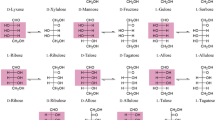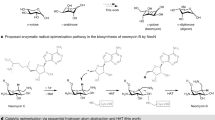Abstract
Sugar (carbohydrate) epimerases catalyze the reversible conversion of a sugar epimer into its counterpart form. More than 20 types of sugar epimerase have been reported to date, and their biological properties, catalytic mechanisms, and 3D structures are very diverse among them. Recently, microbial sugar epimerases have been characterized in detail. This review surveys the catalytic aspects of microbial epimerases, which are relevant for production of bioactive mono- and oligosaccharides.



Similar content being viewed by others
References
Allard STM, Giraud MF, Naismith JH (2001) Epimerases: structure, function and mechanism. Cell Mol Life Sci 58:1650–1665
Amein M, Leatherwood JM (1969) Mechanism of cellobiose epimerase. Biochem Biophys Res Commun 36:223–227
Bhuiyan SH, Itami Y, Rokui Y, Katayama T, Izumori K (1998) D-Allose production from D-psicose using immobilized L-rhamnose isomerase. J Biosci Bioeng 85:539–541
Caruthers J et al (2006) Structure of a ribulose 5-phosphate 3-pimerase from Plasmodium falciparum. Proteins 62:338–342
Cataldi TR, Angelloti M, Bufo SA (1999) Method development for the quantitative determination of lactulose in heat-treated milks by HPAEC with pulsed amperometric detection. Anal Chem 71:4919–4925
Centeno MSJ et al (2006) Galactomannan hydrolysis and mannose metabolism in Cellvibrio mixtus. FEMS Microbiol Lett 261:123–132
Datta A (1970) Regulatory role of adenosine triphosphate on hog kidney N-acetyl-D-glucosamine 2-epimerase. Biochemistry 9:3663–3770
Dong CJ et al (2003) High-resolution structures of RmlC from Streptococcus suis in complex with substrate analogs locate the active site of this class of enzyme. Structure 11:715–723
Dong C et al (2007) RmlC, a C3’ and C5’ carbohydrate epimerase, appears to operate via an intermediate with an unusual twist boat conversion. J Mol Biol 365:146–159
Field RA, Naismith JH (2003) Structural and mechanistic basis of bacterial sugar nucleotide-modifying enzymes. Biochemistry 42:7637–7647
Granström TB, Takata G, Tokuda M, Izumori K (2004) Izumoring: a novel and complete strategy for bioproduction of rare sugars. J Biosci Bioeng 97:89–94
Hahn-Hägerdal B, Karhumaa K, Fonseca C, Spencer-Martins I, Gorwa-Grauslund MF (2007) Towards industrial pentose-fermenting yeast strains. Appl Microbiol Biotechnol 74:937–958
Ishida Y, Kamiya T, Izumori K (1997) Production of D-tagatose 3-epimerase of Pseudomonas cichorii ST-24 using recombinant Escherichia coli. J Ferment Bioeng 84:348–350
Ito S et al (2007) Cloning and sequencing of the cellobiose 2-epimerase gene from an obligatory anaerobe, Ruminococcus albus. Biochem Biophys Res Commun 360:640–645
Ito S et al (2008) Enzymatic properties of cellobiose 2-epimerase from Ruminococcus albus and the synthesis of rare oligosaccharides by the enzyme. Appl Microbiol Biotechnol 79:433–441
Ito S et al (2009) Site-directed mutagenesis of possible catalytic residues of cellobiose 2-epimerase from Ruminococcus albus. Biotechnol Lett 31:1065–1071
Itoh T et al (2000) Crystal structure of N-acyl-D-glucosamine 2-epimerase from porcine kidney at 2.0 Å resolution. J Mol Biol 303:733–744
Jeffries TW, Jin YS (2004) Metabolic engineering for improved fermentation of pentoses by yeasts. Appl Microbiol Biotechnol 63:495–509
Kim HJ, Hyun EK, Kim YS, Lee YJ, Oh DK (2006a) Characterization of an Agrobacterium tumefaciens D-psicose 3-epimerase that converts D-fructose to D-psicose. Appl Environ Microbiol 72:981–985
Kim K, Kim HJ, Oh DK, Cha SS, Rhee S (2006b) Crystal structure of D-psicose 3-epimerase from Agrobacterium tumefaciens and its complex with true substrate D-fructose: a pivotal role of metal in catalysis, an active site for the non-phosphorylated substrate, and its conformational changes. J Mol Biol 361:920–931
Kuyper M et al (2005) Evolutionary engineering of mixed-sugar utilization by a xylose-fermenting Saccharomyces cerevisiae strain. FEMS Yeast Res 5:925–934
Lee YC, Wu HM, Chang YN, Wang WC, Hsu WH (2007) The central cavity from the (alpha/alpha)6 barrel structure of Anabaena sp. CH1 N-acetyl-D-glucosamine 2-epimerase contains two key histidine residues for reversible conversion. J Mol Biol 367:895–908
Levin GV (2002) Tagatose, the new GRAS sweetener and health product. J Med Food 5:23–36
Lu Y, Levin GV, Donner TW (2008) Tagarose, a new antidiabetic and obesity control drug. Diabetes Obes Metab 10:109–134
Luchansky SJ, Yarema KJ, Takahashi S, Bertozzi CR (2003) GlcNAc 2-epimerase can serve a catabolic role in sialic acid metabolism. J Biol Chem 278:8035–8042
Luska L, Krause M, Danker K, Reutter W, Horstkorte R (1999) Primary structure and expression analysis of human UDP-N-acety-glucosamine-2-epimerase/N-acetylmannosamine kinase, the bifunctional enzyme in neuraminic acid biosynthesis. FEBS Lett 454:341–344
Martinez-Castro I, Olano A, Corzo N (1986) Modifications and interactions of lactose with mineral components of milk during heating processes. Food Chem 21:211–221
Matsuo T, Shirai Y, Izumori K (2001) Effects of dietary D-psicose on diurnal variation in plasma glucose and insulin concentrations of rats. Asia Pacific J Clin Nutr 10:233–237
Melo A, Glaser L (1968) The mechanism of 6-deoxyhexose synthesis. II. Conversion of deoxythymidine diphosphate 4-keto-6-deoxy-D-glucose to deoxythymidine diphosphate L-rhamnose. J. Biol Chem 243:1475–1478
Menavuvu BT et al (2006) Efficient biosynthesis of D-allose from D-psicose by cross-linked recombinant L-rhamnose isomerase: separation of product by ethanol crystallization. J Biosci Bioeng 101:340–345
Miyamoto M, Ajisaka K (2004) Regioselectivity in β-galactosidase-catalyzed transglycosylation for the enzymatic assembly of D-galactosyl-D-mannose. Biosci Biotechnol Biochem 68:2086–2090
Moreno FJ, Villamiel M, Olano A (2003) Effect of high pressure on isomerization and degradation of lactose in alkaline media. J Agric Food Chem 51:894–1896
Murao K et al (2007) D-Psicose inhibits the expression of MCP-1 induced by high-glucose stimulation in HUVECs. Life Sci 81:592–599
Murata A et al (2003) A novel inhibitory effect of D-allose on production of reactive oxygen species from neutrophils. J Biosci Bioeng 96:89–91
Nakakuki T (2005) Present status and future prospects of functional oligosaccharide development in Japan. J Appl Glycosci 52:267–271
Nishimukai M et al (2008) Effects of epilactose on calcium adsorption and serum lipid metabolism in rats. J Agric Food Chem 56:10340–10345
Oh DK (2007) Tagatose: properties, applications, and biotechnological processes. Appl Microbiol Biotechnol 76:1–8
Oshima H, Kimura I, Izumori K (2006) Psicose contents in various food products and its origin. Food Sci Technol Res 12:137–143
Pacheco B, Maccarana M, Goodlett DR, Malmström A, Malmström L (2009) Identification of the active site of DS-epimerase 1 and requirement of N-glycosylation for enzyme function. J Biol Chem 284:1741–1747
Samuel J, Tanner ME (2002) Mechanistic aspects of enzymatic carbohydrate epimerization. Nat Prod Rep 19:261–277
Sato M, Kurose H, Yamasaki T, Izumori K (2008) Potential anthemintic: D-psicose inhibits motility, growth and productive maturity of L1 larvae of Caenorhabditis elegans. J Nat Med 62:244–246
Schauer R (1982) Sialic acids—chemistry, metabolism, and function. Springer, New York, pp 263–305
Schmitz C et al (2000) Normal blood pressure and plasma renin activity in mice lacking the rennin-binding protein, a cellular renin inhibitor. J Biol Chem 275:15357–15362
Sedlak M, Ho NWY (2004) Production of ethanol from cellulosic biomass hydrolysates using genetically engineered Saccharomyces yeast capable of cofermenting glucose and xylose. Appl Biochem Biotechnol 113–116:404–416
Senoura T et al (2009) Identification of the cellobiose 2-epimerase gene in the genome of Bacteroides fragilis NCTC 9343. Biosci Biotechnol Biochem 73:400–406
Shi R et al (2008) Structure of L-xylulose 3-epimerase (UlaE) from the anaerobic L-ascorbate utilization pathway of Escherichia coli: identification of a novel phosphate binding motif within a TIM barrel fold. J Bacteriol 190:8137–8144
Sui L et al (2005) The inhibitory effect and possible mechanisms of D-allose on cancer cell proliferation. Int J Oncol 27:907–912
Sun Y, Hayakawa S, Ogawa M, Fukada K, Izumori K (2008) Influence of a rare sugar, D-psicose, on the physicochemical and functional properties of an aerated food system containing egg albumin. J Agric Food Chem 56:4789–4796
Taguchi H et al (2008) Cloning and sequencing of the gene for cellobiose 2-epimerase from a ruminal strain of Eubacterium cellulosolvens. FEMS Microbiol Lett 287:34–40
Tyler TR, Leatherwood JM (1967) Epimerization of disaccharides by enzyme preparations from Ruminococcus albus. Arch Biochem Biophys 119:363–367
Watanabe J et al (2008) Prebiotic properties of epilactose. J Dairy Sci 91:4518–4526
Wisselink HW et al (2007) Engineering of Saccharomyces cerevisiae for efficient anaerobic alcoholic fermentation of L-arabinose. Appl Environ Microbiol 73:4881–4891
Wisselink HW et al (2009) Novel evolutionary engineering approach for accelerated utilization of glucose, xylose, and arabinose mixtures by engineered Saccharomyces cerevisiae strains. Appl Environ Microbiol 75:907–914
Yamaguchi S, Ohnishi J, Maru I, Ohta Y (2006) Simple and large-scale production of N-acetylneuraminic acid and N-acetyl-D-mannosamine. Trends Glycosci Glycotechnol 18:245–252
Yamaguchi F et al (2008) Rare sugar D-allose induces specific up-regulation of TXNIP and subsequent G1 cell cycle arrest in hepatocellular carcinoma cells by stabilization of p27kip1. Int J Oncol 32:377–385
Yoshida H et al (2007) Crystal structures of D-tagatose 3-epimerase from Pseudomonas cichorii and its complexes with D-tagatose and D-fructose. J Mol Biol 374:443–453
Zhang L, Mu W, Jiang B, Zhang T (2009) Characterization of D-tagatose-3-epimerase from Rhodobacter sphaeroides that converts D-fructose into D-psicose. Biotechnol Lett. doi:https://doi.org/10.1007/s10529-009-9942-3
Ziemer C, Gibson G (1998) An overview of probiotics, prebiotics and synbiotics in the functional food concept: perspectives and future strategies. Int Dairy J 8:473–479
Acknowledgments
Part of our studies that appeared in this review was done at the Institute of Creative Research Initiative (CRIS) of Hokkaido University, Sapporo, Japan, and supported by the Special Coordination Funds for Promoting Science and Technology, Ministry of Education, Culture, Sports, Science and Technology, Japan.
Author information
Authors and Affiliations
Corresponding author
Additional information
According to the definition by the International Society of Rare Sugars (Granström et al. 2004), “rare sugar” is the term restricted to a “mono-saccharide” that exists in nature but are only present in limited quantities. In this review, “sugars” simply mean carbohydrates, mono- and oligosaccharides, or their derivatives.
Rights and permissions
About this article
Cite this article
Ito, S. Features and applications of microbial sugar epimerases. Appl Microbiol Biotechnol 84, 1053–1060 (2009). https://doi.org/10.1007/s00253-009-2179-1
Received:
Revised:
Accepted:
Published:
Issue Date:
DOI: https://doi.org/10.1007/s00253-009-2179-1




